Ludzie nie dlatego
przestają się bawić,
że się starzeją,
lecz starzeją się,
bo się przestają bawić.
Mark Twain
przestają się bawić,
że się starzeją,
lecz starzeją się,
bo się przestają bawić.
Mark Twain

| STRONA GŁÓWNA |
| NAJBLIŻSZE SPOTKANIA |
| JĘZYK ANGIELSKI |
| JĘZYK FRANCUSKI I NIEMIECKI |
| KLUB SENIORA EUROPEJCZYKA |
| KURSY KOMPUTEROWE |
| Z ŻYCIA AKADEMII |
| O NAS |
| PROJEKTY |
| NASI PARTNERZY |
| GALERIA |
| ENGLISH |
| KONTAKT |

Stowarzyszenie Akademia Pełni Życia
im. Joanny Boehnert
ul. Władysława Łokietka 57A/39
31-279, Kraków
Adres korespondencyjny,
biuro i miejsce zajęć:
ul. Rzeźnicza 2A
31-540, Kraków
tel. 12 294 81 35 oraz 12 431 36 00
E-mail: biuro@apz.org.pl
BIURO AKADEMII CZYNNE:
od poniedziałku do piątku
w godz. 9.00 - 11.00
Zapraszamy!
Akademia Pełni Życia

im. Joanny Boehnert
ul. Władysława Łokietka 57A/39
31-279, Kraków
Adres korespondencyjny,
biuro i miejsce zajęć:
ul. Rzeźnicza 2A
31-540, Kraków
tel. 12 294 81 35 oraz 12 431 36 00
E-mail: biuro@apz.org.pl
BIURO AKADEMII CZYNNE:
od poniedziałku do piątku
w godz. 9.00 - 11.00
Zapraszamy!

The History of the Jagiellonian University
Julita Maciejewicz - Ryś, Maria KacprzyckaThe Jagiellonian University in Kraków is the oldest Polish university and one of the oldest in the world. It was established in 1364 by King Casimir the Great.

A statuette of King Casimir the Great, photo by J. Podolecki
After the University in Prague, it was the second university to be founded in Central Europe. Initially, the University consisted of three faculties (law, liberal arts, medicine), since Pope Urban V did not grant permission to establish the most prestigious faculty of theology. Unfortunately, after King Casimir's death, his successor, King Louis of Anjou, showed lack of interest in the University's development, which led to the suspension of academic activities. The University was restored in 1400, owing to the endeavours of Queen Jadwiga, the wife of King Ladislaus Jagiello. The Queen personally pleaded the University's case with the Pope in Avignon. In her will, she bequeathed her personal effects to the University. The Queen's jewellery allowed for the restoration of the University with four faculties characteristic of medieval universities, including the most important one, that is theology.

Queen Jadwiga painted by Marcello Bacciarelli
According to Klemens Bąkowski, the author of "Dzieje Wszechnicy Krakowskiej" [The History of the Jagiellonian University] (1900), "the Queen founded the Lithuanian College in Prague and endowed it with a year income of 200 grzywna (grzywna is a medieval monetary unit) in order to supply priests for the newly converted Lithuania, because the faculty of theology, which was granted permission by the Pope at the time, had to be yet established."
The University was restored in a new building, which has been known since that time as Collegium Maius. In the 15th century it had been extended several times.
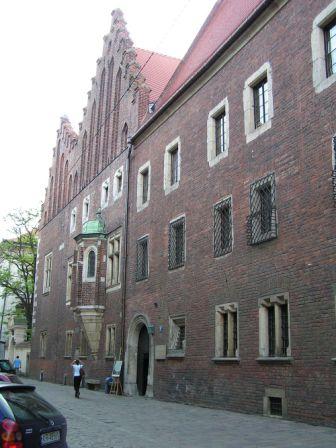
Collegium Maius, photo by J. Podolecki
At the time, the University attracted foreign students, who comprised 50% of the University's overall number of students in the 15th century. The school of mathematics and astrology, where Nicolaus Copernicus had been studying in years 1491-1495, was particularly famous.
The reconstruction of Collegium Maius, after a conflagration in 1492, was carried out under the charge of the builder Jan and gave it a uniform architectural character. The inner court was given its present shape, which alluded to the court of Collegio di Spagna in Bologna /photograph 3/.
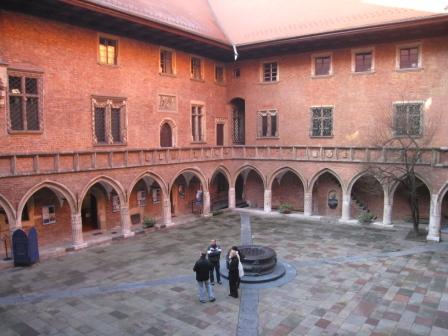
The arcaded court, photo by A. Baran
In 1507 another stage of expansion began - first, the lecture theatre was erected; then, Libraria, i.e. the library, which proved to be indispensible because, after the invention of print, the book collection of the Jagiellonian University increased considerably. The only part of the old library that survived up to this day is the beautiful portal, which dates back to 1494, known as the Golden Gate. Now, it constitutes the main entrance to Libraria from the gallery of the first floor.
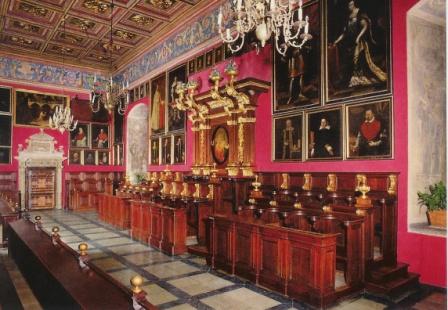
The Assembly Hall, photo by J. Podolecki
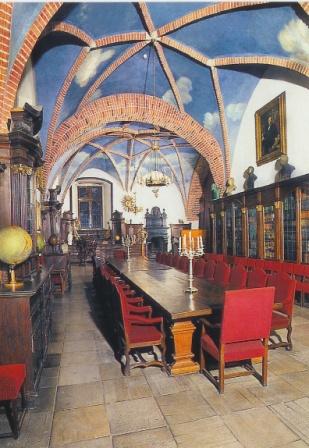
The old library, photo by J. Podolecki
In 1517, a well was built in the middle of the court. The water was said to be crystal-clear. In the 1950s the well was given a casing made of black Dębnik limestone, known locally as "Dębnik marble". In the end of the 16th century the University was gradually losing its significance. It was being abandoned by foreign students, halls of residence were being closed, and young noblemen were becoming less and less interested in studying in Kraków. In the 18th century the situation changed with the introduction of reforms initiated by Hugo Kołłątaj, the author of the May 3rd Constitution of 1791, one of the creators of the Commission for National Education, and the reformer of the Polish educational system in the 18th century. At the time, lectures, which had been delivered in Collegium Maius, were transferred to the new, spacious building of Collegium Physicum at ul. św. Anny 6. In years 1840-1870, Collegium Maius was undergoing serious reconstruction in neo-Gothic style. After the building works had been completed, the Collegium was alloted to the Jagiellonian Library, which had been located there until 1940. Due to the continuous development of the University, the construction of a new building, Collegium Novum, began. In 1887 the works were completed. The building has been housing the administrative centre of the university, a lecture theatre, and numerous lecture halls.

Collegium Novum, photo by A. Baran
In the lecture theatre of the building, one can see portraits of outstanding professors, such as Józef Dietl or Józef Szujski, and the famous painting "Astronomer Copernicus: Conversation with God" by Jan Matejko.
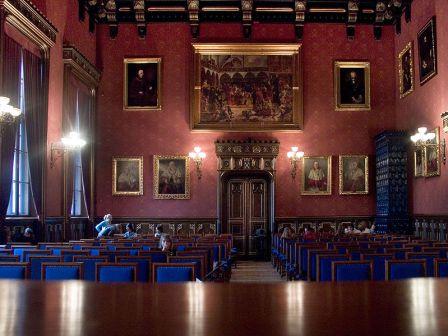
Lecture Hall of Collegium Novum, photo by I. Grabska
In the interwar period, the Jagiellonian University, along with the Jan Kazimierz University in Lwów, became a breeding ground for the research personnel of all Polish universities. The period of the Second World War was a dramatic one for the University. On 6th November 1939 Nazi German soldiers arrested and sent to concentration camps 183 academics of Kraków. During the war, the University had been closed and its interiors had been destroyed. However, the academic society of Kraków did not surrender. Just as in other parts of Poland, clandestine teaching was organised also in Kraków. The clandestine Jagiellonian University had about 900 students. After the war, another reconstruction of Collegium Maius began, this time under Professor Karol Estreicher Jr's direction. The building was given its shape from before 1840. The reconstruction works were completed for the 600th Jubilee of the Jagiellonian University in 1964. Collegium Maius hosts the Museum of the Jagiellonian University which owns a unique collection of scientific instruments, numerous university keepsakes and a portrait gallery of professors.
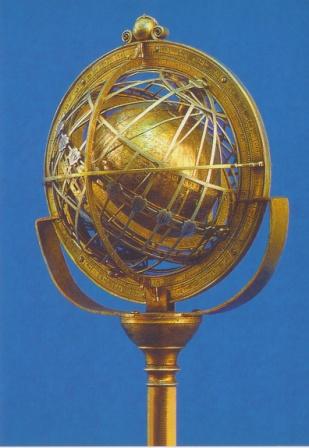
The so-called jagiellonian Globe, photo by J. Podolecki

The Globe Room, photo by J. Podolecki

The Room of the Commision of National Education with collection of astronomical instruments, photo by J. Podolecki
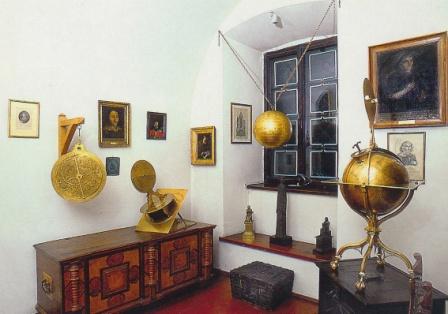
Nicolaus Copernicus' Room, photo by J. Podolecki
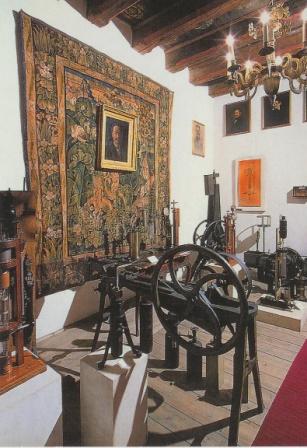
Collection od instruments used by pof. Olszewski i prof. Wróblewski in their experimental liquefaction of oxygen in 1883, photo by J. Podolecki
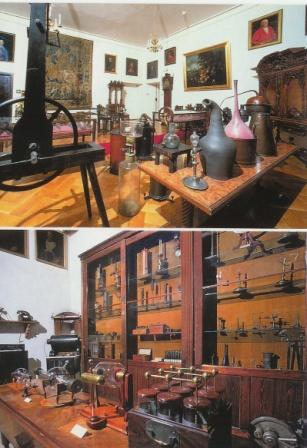
The Chemistry Room and the Physics Room, photo by J. Podolecki
Today, after furnishing exhibition halls, Collegium Maius has become the centre of the University's life - it is here that the sessions of the University's Senate, habilitation colloquiums and conferrals of honorary degrees (e.g. on John Paul II in 1983) take place and annual prizes and honours are awarded. Annually, on the 1st October, a procession of professors dressed in gowns marches from Collegium Maius to the lecture theatre in Collegium Novum to inaugurate a new academic year.
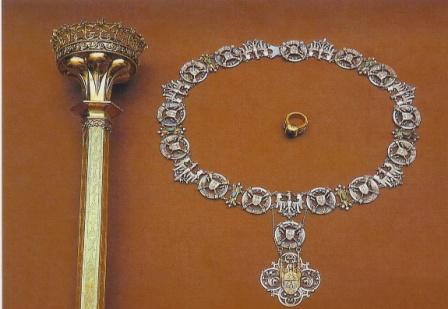
Rector's insygnia, photo by J. Podolecki
After 1989, following the change of the political system in Poland, the University could start functioning on new conditions, and its autonomy was restored. In 1993 Collegium Medicum was reincorporated into the University's structures. Up to 2004, the Jagiellonian University was the only university in Poland with a medical faculty. The University continues developing international cooperation. It is a member of the Coimbra Group, an association of the oldest universities in Europe. Since 1999 the University has been functioning in a constantly expanded University's campus, where the newest scientific and technological infrastructure found its place.
Sources:
K. Bąkowski (1900). Dzieje Wszechnicy Krakowskiej.
J. Podlecki i S. Waltoś (1999). Collegium Maius Uniwersytetu Jagiellońskiego, Kraków: Wydawnictwo Karpaty.
M. Rożek (1989). Zwiedzamy Kraków. Kraków: PTTK Kraj.
J. Roszko (1983). Collegium Maius i jego lokatorzy. Kraków: Krajowa agencja Wydawnicza.
J. Adamczewski (1989). Ilustrowany przewodnik po Krakowie. Warszawa: Interpress.
http://pl.wikipedia.org/wiki/Collegium_Maius_Uniwersytetu_Jagiellońskiego
Powrót do strony głównej projektu
Powrót do Tekstów i prezentacji